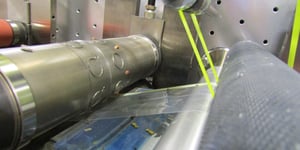With most of the world connected online, innovation might seem like a labyrinth of endless ideas.
However, if you can find a strategy that works for your company, you’ll already be well on your way to establishing your own method of production.
Whether you’re looking to improve the quality of your own production or find a converter you can trust, you should still understand how die-cutting may help your business.
Efficiency
Arguably the most significant advantage of die cut adhesive tape is the efficiency with which it can be produced.
As they develop more products, your company might say, “I think there’s a better/smarter/faster way we could be doing this,” and innovate beyond the initial solution.
Converters want to simplify the process as much as possible, and die cutting is the perfect way. It allows businesses to condense multiple steps of their project into one location.
There’s no need for an adhesive part to be painstakingly cut out, sent hundreds of miles for lamination, then transferred back for packaging before it even goes out to the final buyer. Instead, a converter could invent a set-up that can complete multiple steps in quick succession.
A decent supply of samples also enables companies to choose the best option based on their experience with the initial batch. This feedback will improve the production quality for both the business and the converter.
Automation
Preparing our parts for automation is the duty of an excellent converter.
Automation is the process of using advanced technology to innovate the manufacturing process. This is typically done to fulfill repetitive tasks on behalf of the workers.
Often, automation involves attaching a smaller, pre-made part to a new, larger object, like using a robot to attach tires onto a new car. On the other hand, it could also mean altering the product to make it usable.
To succeed in automation, a company must trust that the smaller parts have consistent measurements. Die cut adhesives are manufactured in bulk and share the same dimensions as the rest of the batch.
This allows product assembly to run faster and renders the products more accessible for customer use.
Automation can be as simple as kiss cutting crack-and-peel or pull tabs on an adhesive for easier application.
The automation process can also be used during product packaging, which is often done automatically. Packaging straight off the press will save time and reduce skin-to-product handling, which is handy for many medical devices.
Reducing costs
Methods like rotary die cutting can innovate your entire manufacturing process, consolidating multiple steps into one process to eliminate the need for numerous manufacturing sources.
If you wish to avoid high shipping costs, consolidation is the key.
There aren’t many options besides die cutting except for cutting out the parts by hand, which is only possible if you have the funds to pay a team of assembly line workers.
Yet even with the budget to hire more people, die-cutting machines can produce adhesives faster and more accurately than any employee with a pair of scissors.
This plan allows you to knock out two birds with one stone. A die cut press will allow you to mass-produce adhesives, which will also expand the scale of your production.
Excellent converters treat high-volume jobs as opportunities for continuous improvement.
Die cutting is ideal for producing custom adhesives en masse, saving machine run-time hours.
Methods
There are three primary methods of producing adhesives on a large scale: Flatbed, rotary, and laser die cutting.
Each method has advantages and disadvantages, so it’s essential to understand the part dimensions and their intended use before deciding which will work best.
Factors to consider are the part tolerance, the type of material, and the scale of production.
Jobs with a tight tolerance require heavy detail and can’t withstand many discrepancies before becoming unusable. Although, due to their size, they often suffer the most mistakes.
Lastly, if you need many parts, it’s worth considering a method more suited to rapid production.
FLATBED CUTS
Flatbed die cutting occurs when a die is lowered onto a static material from above.
This is the simplest form of die cutting, and it comes with multiple advantages.
One advantage in flatbed die cutting is size capabilities, primarily the ability to create parts with larger dimensions. Certain pieces are too wide to fit onto a rotary press but might fit underneath a flatbed die.
During flatbed die cutting, the material is static, so it doesn’t suffer the same tension as when pulled through a press. Changes in a material’s stress will alter the length of the cut ever so slightly, which will influence the final product.
Unfortunately, the pauses in between cuts means that flatbed die cutting can be slower than other die cutting methods.
Also, a flatbed press is typically one station, meaning it’ll take multiple steps to create your finished product. A single adhesive piece could be transported to various stations for printing, cutting, laminating, et cetera.
If you’re looking for the best manufacturing process to create accurate, small to mid-sized batches, flatbed die cutting could be your most effective strategy.
ROTARY CUTS
Rotary die cutting is an excellent option if you’re searching for a quick and efficient production method.
Rotary die cut adhesives are produced when the material is run underneath a cylindrical die.
The continuous motion of the rotary die can create a large number of die cut adhesives. Still, the constant tension of the press makes it less suited to cut materials like foam or stretchy polyurethanes.
Rotary die cutting can be a highly innovative process for creating parts because it lends itself to automation.
Multiple steps can be taken at one station: Parts can be brought through a printer before getting cut, eliminating the need for back-and-forth transportation.
LASER CUTS
Laser die cutting can achieve the tightest of tolerances.
Laser die cutting may be your best strategy if your adhesive requires precise measurements.
But before you choose, consider the many factors which rule out laser die cutting.
Some materials shouldn’t be laser cut, such as metals. For instance, if copper tape is your material, you’re better off using another method.
Laser cutting is typically used for single-step projects due to the added difficulty of mounting extra pieces such as a printer or laser onto a press.
It’s necessary to consider the thickness of the material to determine if laser cutting is ideal.
Materials that are too thick or dense will cut slowly, and the laser angle could bend while passing through them.
Overall, the laser cutting process tends to be slower than its alternatives. Instead of punching out a part in one motion, the laser must trace its way around each shape, which requires time. For this reason, laser die cutting isn’t as popular for mass production.
If you’re looking for an experienced converter to produce die cut adhesives, look no further: Strouse has your back.
Let us know what your project is, or stay in touch if you’re planning on using die cut adhesives sometime in the future.





